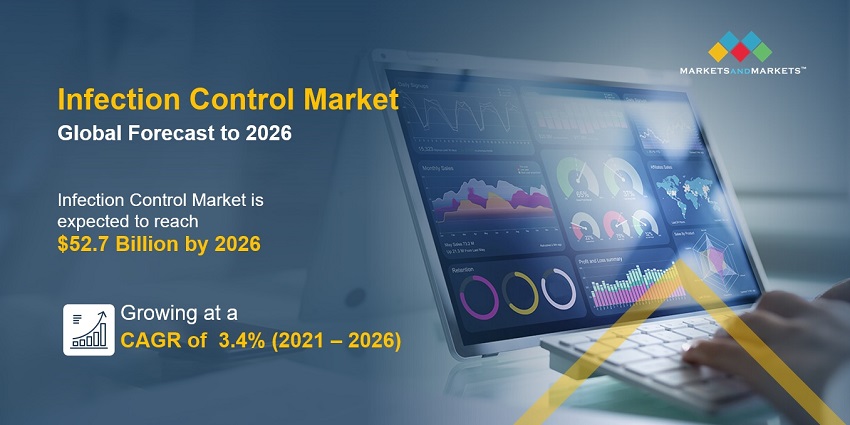Infection Control Market worth $52.7 billion by 2026

According to the new market research report "Infection Control Market by Product (Sterilization (Steam, Hydrogen Peroxide, EtO), Disinfection (Wipes, Liquids, Disinfectors), Services, E-beam, Face Masks), End User (Hospitals, Pharmaceutical Companies), COVID-19 Impact - Global Forecast to 2026", published by MarketsandMarkets™, the market is projected to reach USD 52.7 billion by 2026 from USD 44.7 billion in 2021, at a CAGR of 3.4% during the forecast period.
Browse in-depth TOC on "Infection Control Market"
557 – Tables
55 – Figures
550 – Pages
Download PDF Brochure: https://www.marketsandmarkets.com/pdfdownloadNew.asp?id=1084
the growing geriatric population and increasing incidence of chronic diseases; the growing focus on food sterilization and disinfection; technological advancements in sterilization equipment; and the increasing outsourcing of sterilization services among pharmaceutical companies, hospitals, and medical device manufacturers. The growing number of medical device and pharmaceutical companies in emerging economies, increasing use of E-beam sterilization, re-introduction of ethylene oxide sterilization, and outsourcing operations to emerging countries with an improving healthcare sector will also support the growth of the infection control market in the coming years.
Rising adoption of single-use medical nonwovens and devices;
Globally, the number of surgical procedures performed annually has increased significantly due to the rising geriatric population and the growing prevalence of obesity and diabetes. This has increased the demand for disposable medical products or single-use products that can be disposed of after use, reducing the chances of infection transmission. The rising per capita healthcare spending and the increasing importance of maintaining hygiene and sterility are also expected to increase the demand for single-use medical nonwoven products. The outbreak of pandemics such as H1N1, SARS, and COVID-19 and viral diseases such as Zika virus, yellow fever, Ebola, and dengue has also increased the demand for single-use medical nonwoven products.
The Infection Control Market for protective apparel and textiles is expected to witness significant growth owing to hospitals' rising focus on reducing the risk of HAIs. This trend is expected to increase the use of premium barrier-enhanced medical nonwovens such as gloves, drapes, gowns, face masks, and other apparel. The proper and effective sterilization of instruments, drapes, and supplies used in operating rooms, emergency treatment areas, and intensive care units significantly reduces the chance of infection. Single-use systems, such as tubing, capsule filters, single-use mixers, bioreactors, product-holding sterile bags, and other components are typically pre-sterilized, eliminating the need for sterilization before use.

Over the years, there has been a significant rise in the number of surgical procedures performed worldwide. This is attributed to the growing prevalence of obesity and other lifestyle diseases, the rising geriatric population, and the increasing incidence of spinal injuries and sports-related injuries.
The growing number of surgical procedures performed has resulted in the increasing demand for different surgical equipment and medical devices during these procedures. This is expected to drive the demand for infection control products and services due to the proven benefits of sterilized products and growing awareness about their effectiveness in infection control health settings.
According to the National Center for Biotechnology Information (NCBI, US), there has been a significant increase in the number of surgical procedures in the US over the last decade, and this trend is expected to continue in the coming years.
Thus, with growth in the number of surgeries, the need for infection control is also increasing as improper sterilization of equipment used in surgical procedures or inadequately disinfected hospitals/clinics could lead to growth in the number of HAI and SSI cases. This is expected to play a key role in the greater uptake of infection control technologies in the coming years, propelling the growth of the market during the forecast period.
- Art
- Causes
- Crafts
- Dance
- Drinks
- Film
- Fitness
- Food
- Games
- Gardening
- Health
- Home
- Literature
- Music
- Networking
- Other
- Party
- Religion
- Shopping
- Sports
- Theater
- Wellness
- IT, Cloud, Software and Technology


